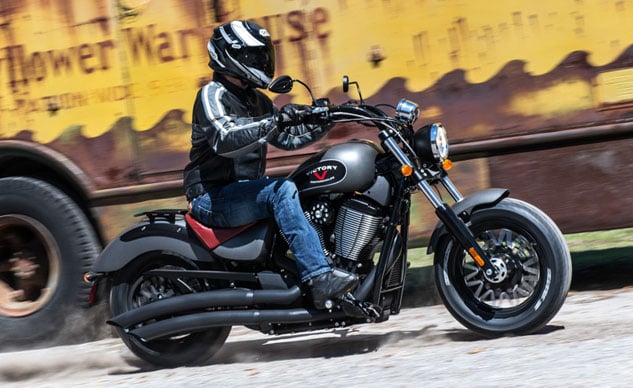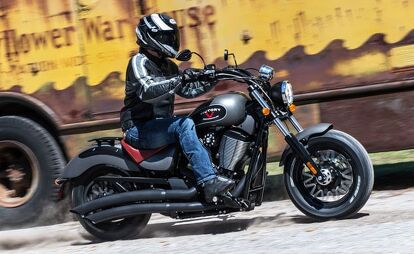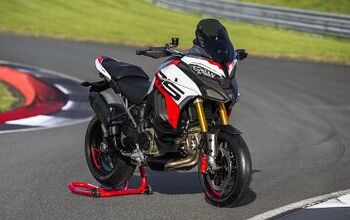2015 Victory Gunner Review - First Ride

Proving that less can be more
When Victory Motorcycles announced the Gunner, we were frankly a little perplexed. The Gunner was listed as a bobber, but Victory already had a bobber in the Judge. What made this motorcycle different? Who was it designed for? Our readers added another question to the list when they claimed that the Judge wasn’t really a bobber. So, when Victory contacted us to see if we’d like to ride the Gunner during Bike Week, we gave an unequivocal yes as our answer.
2015 Victory Gunner
| Engine | 18.5/20 |
| Suspension/Handling | 12.75/15 |
| Transmission/Clutch | 8.75/10 |
| Brakes | 8.25/10 |
| Instruments/Controls | 3.75/5 |
| Ergonomics/Comfort | 9.25/10 |
| Appearance/Quality | 9/10 |
| Desirability | 9/10 |
| Value | 8.75/10 |
| Overall Score | 88/100 |
Out of the gate, in the short technical briefing, given while standing in the Victory vendor area next to the Daytona Int’l Speedway, the first two questions were almost immediately answered without prompting. Apparently, Victory understands the need to define who they think the bike is designed for and why. The goal of the Gunner was to produce a stripped-down, aggressively styled cruiser with Big Twin power. The minimalist approach served two purposes. First, by carrying less weight, the Gunner would allow the Freedom 106 engine to deliver more fun per foot pound of torque – which can only be measured by the seat-of-the-pants and not on a dynamometer.
Second, Victory wanted to keep the Gunner’s price low to provide a gateway into the Victory fold for riders whose tastes don’t lean towards the Vegas 8-Ball. Remember that, while they certainly want to sell you your next motorcycle, Victory – and all the manufacturers, to some degree – is playing the long game. They want to sell you all your future motorcycles, too. They want you to become a part of the Victory family for life. All of the manufacturers taking on the 800-lb. gorilla in the cruiser world are doing this, and they don’t have the luxury of time to allow it to happen over decades like Harley did. Don’t believe it? Take a look at all the brand-specific events scheduled at Bike Week and the other major rallies.
So, within that context, the Gunner begins to make more sense. Priced at $12,999 ($500 more than the Vegas 8-Ball), the Gunner is Victory’s second least expensive motorcycle and sports a muscular style quite different from its sibling’s skinny 21-in. front wheel and slightly more raked out fork. The Gunner’s stance is purposeful with a solo saddle, pulled-back bar and abbreviated fenders.
Just walking up to the Gunner, you can tell at first glance this bike is all about the engine. The Suede Titanium Metallic and Black two-tone paint scheme and the blacked-out dually exhaust make the eyes naturally draw to the machined metal on Victory’s signature shaped, closely spaced cylinder fins. The same can be said of the 24-spoke cast aluminum wheels. Only the machined edges break the darkness of the wheels. In fact, the uses of bare metal and chrome appear to be well thought out. You can even count the categories of components that don’t wear a dark treatment on two hands and have a finger left over: engine, wheels, tires (white lettering), fork, headlight ring, speedometer housing, levers, tank pinstriping, and various nuts and bolts.
So, dark and muscular. We get it, but it wouldn’t mean a thing if the Gunner didn’t have the chops to carry the tough-guy image. The Freedom 106 engine, which was introduced in 2008 to propel Victory’s Vision line of tourers (and added to the entire Victory line of motorcycles in 2011), has an affirmative answer to that requirement. In most tests of a Victory motorcycle featuring the Freedom 106 we’ve covered on MO, we’ve noted our fondness for the powerplant. (Just take a look at this Victory Judge review, for example.)
Our affinity for the 106 doesn’t necessarily mean that the engine is without flaws. Since their inception, Victory engines have had a characteristic clunkiness in the transmission. On the Gunner, it felt slightly slicker than the last model we tested. A discussion with Victory reps about the tranny revealed that they have no knowledge of any changes to the cogs in the 6-speed gearbox, but they noted that Victory is constantly refining its manufacturing process and perhaps this explained the perceived difference. Regardless, this change was noticeable. Another notable difference was a slight abruptness in transitioning from on-off-on throttle states at parking-lot speeds or moseying in the traffic for which Daytona Bike Week is so (in)famous. This abruptness is really a quality of life issue rather than a huge problem, though.
The engine’s power is ample, and the delivery is a hoot. Whacking on the throttle at just about any speed makes the Gunner shoot forward (sorry, it had to be done) with authority. It even has the oomph to purposefully launch the bike from second gear – not that any MO staffer would ever forget to downshift to first. Everywhere across the rpm range, the Gunner’s engine feels more powerful than previous Victory cruisers. So, how is it that an unchanged engine feels stronger? Easy, the Gunner carries less weight. While the frame is essentially the same item as the Gunner’s cruiser siblings, the bike’s mass has been lessened to the tune of about 10 pounds.
The weight loss doesn’t sound like much until you consider where it was removed. According to the press briefing, “most” of the weight loss was courtesy of the spiffy new 16-in. wheels. So, aside from having a cool, spoke-wheel-like look, the new design carries less poundage. This is a technique that Victory – and just about every road racer seeking more acceleration and lightened handling – has used before. Look to the Judge mentioned above for an instance in which Victory employed this. The lessened rotational mass means that the wheels can accelerate quicker while also carrying the handling advantage of turning quicker and having less unsprung weight. When riding a Gunner fit with Victory’s Stage 1 exhaust kit, which happens to be lighter and deliver a massaged power curve (plus a street-reasonable exhaust note), the Gunner’s power delivery bumped up a noticeable couple of percentage points.
Riding the Gunner around Florida highlighted its enjoyable character. The suspension worked well on the smooth, mostly straight roads we covered. The ground clearance was cruiser average plus a little bit, so the fun didn’t end overly soon in the turns we did encounter. Pegs touched down first and left a decent margin before anything else. Those looking for more ground clearance can opt for the Victory accessory shock that offers a one-inch increase in ride height, giving more travel to damp road irregularities.
The Gunner’s brakes worked well, delivering the power necessary to haul a bike with a claimed dry weight of 649 lb. plus a 170-lb. rider (also a claimed weight). The single 300mm discs, front and rear, provide surprisingly good power and feel when in full-on whoa-mode. The pad compound and the four-piston caliper do a great job of getting the most out of a single front disc. The pedal is well-positioned for the rider’s foot placement on the rubber peg.
At highway speeds, the riding position felt optimal with the slight reach to the bar combatting wind blast which was largely obscured by the rider’s location down in the bike. The foot position is slightly forward of midway without an overly long reach. The stock solo seat feels multi-hundred mile comfortable. However, the factory accessory red seats that appeared to have the exact same shape and padding were not as comfortable. A thick seam that ran under the rider’s butt looks to be the culprit. While the seam is there on the stock seat, the accessory one appears bigger, probably due to the use of thicker material.
Rolling down the road highlights the smoothness of the Freedom 106 engine. At elevated speeds, both the grips and the pegs are still. Even sampling a set of billet grips, with no rubber padding to damp vibration, the vibes are barely noticeable. Oddly, the mirrors blurred so badly at speeds above 65 mph that they were practically unusable while the grips remained smooth. Perhaps this is a resonance with the frequency of vibrations coming from the road.
A couple hours on a new bike isn’t enough to give a complete review of its capabilities. However, the saddle time was plenty to learn the large strokes of the Gunner’s character. Victory has created a stylish and capable cruiser with tons of attitude and a fit and finish that belies its low (for big-inch cruisers) price. While you don’t get any bells and whistles, like color options or ABS, $12,999 buys a Big Twin with plenty of attitude, performance, and comfort. The extra dollars saved with the Gunner over other Victory models could go towards customization or modification. If you’re buying this bike for its performance, the Victory Stage 1 exhausts might be a good place to start. Victory expects the Gunner in showrooms in early April.
If you’re still wondering if the Gunner is really a bobber, the answer is, as it was the day the bike was announced: The Gunner is as much of a bobber as the law will allow it to be from an OEM.

Like most of the best happenings in his life, Evans stumbled into his motojournalism career. While on his way to a planned life in academia, he applied for a job at a motorcycle magazine, thinking he’d get the opportunity to write some freelance articles. Instead, he was offered a full-time job in which he discovered he could actually get paid to ride other people’s motorcycles – and he’s never looked back. Over the 25 years he’s been in the motorcycle industry, Evans has written two books, 101 Sportbike Performance Projects and How to Modify Your Metric Cruiser, and has ridden just about every production motorcycle manufactured. Evans has a deep love of motorcycles and believes they are a force for good in the world.
More by Evans Brasfield













































Comments
Join the conversation
I like both the Judge and the Gunner as I think they have equal or slightly better motors and brakes (but no ABS on the Gunner) and similar handling for day-to-day riding compared to the lower-priced Dynas. To me - and I am in the market for a cruiser - the biggest trade-off would be the Harley catalogue and resale value against (maybe) $2k savings on the Gunner as I compare the two (can't see buying the Judge over the new Low Rider at almost the same cost). In the end, the Gunner isn't a Harley but is it and Victory's product line enough to be a good option? Just not sure yet. If the Gunner had ABS and was still $1200 less than the Low Rider, this might be an easier question to consider.
And like Chris, I really do want to buy a Victory - just not sure they have the bike for me yet.
This bike looks hot. Here it's $5000 cheaper than the handsome Fat Bob, which seems a close rival style wise. That's a lot!
Why are these bikes so expensive compared to a new VFR or ninja 1000? I think I'd like a ride like the Gunner but you get a lot less for your money feature wise. Lame suspension, no ABS, traction control or anything.